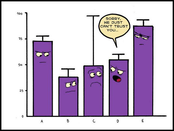internal assessment
Rubrics below come from the IB Biology subject guide online.
Click for a printable summary of IB Biology internal assessment requirements.
Click for a printable summary of IB Biology internal assessment requirements.
Click here for IB Internal Assessment Student Guide
Click here for the IB Internal Assessment Lab Template
Click here for the IB Internal Assessment 6 Part Deadline Guide
IA Overview
The internal assessment requirements are the same for biology, chemistry and physics. The internal
assessment, worth 20% of the final assessment, consists of one scientific investigation. The individual
investigation should cover a topic that is commensurate with the level of the course of study.
Student work is internally assessed by the teacher and externally moderated by the IB. The performance in
internal assessment at both SL and HL is marked against common assessment criteria, with a total mark out
of 24.
The internal assessment requirements are the same for biology, chemistry and physics. The internal
assessment, worth 20% of the final assessment, consists of one scientific investigation. The individual
investigation should cover a topic that is commensurate with the level of the course of study.
Student work is internally assessed by the teacher and externally moderated by the IB. The performance in
internal assessment at both SL and HL is marked against common assessment criteria, with a total mark out
of 24.
IA component
- Duration: 10 hours
- Weighting: 20%
- Individual investigation.
- This investigation covers assessment objectives 1, 2, 3 and 4.
IA criteria
The new assessment model uses five criteria to assess the final report of the individual investigation with the following raw marks and weightings assigned:
The new assessment model uses five criteria to assess the final report of the individual investigation with the following raw marks and weightings assigned:
Click on the links above to get more detailed information about the assessment
Ideas for Internal Assessment
50 IB Biology IA Ideas - IB Better
Online Labs - Ideas and links. This is a list of possible sites for students to use as online labs.
You can access these here http://www.sciencecourseware.org/biologylabsonline (Thanks to Sarah Kelley for the link)
Biology Labs Online have the potential for making biology education more interactive, effective, and fun!
Biology Labs Online is a collaboration between the California State University system and Pearson, Inc..
More online virtual labs here: (Biology, 6/e, Author Dr. George B. Johnson, Washington University,Author Dr. Peter H. Raven, Missouri Botanical Gardens & Washington University,)
Online Labs - Ideas and links. This is a list of possible sites for students to use as online labs.
You can access these here http://www.sciencecourseware.org/biologylabsonline (Thanks to Sarah Kelley for the link)
- FlyLab - genetics of inheritance
- Evolution Lab - adaptation by natural selection
- Translation Lab - the genetic code
- Demography Lab - human population growth
- Hemoglobin Lab - mutations, protein structure/function
- Pedigree Lab - human genetics and RFLP probes
- Mitochondria Lab - electron transport
- Leaf Lab - plant physiology/photosynthesis
- Cardio Lab - cardiovascular homeostasis
- Enzyme Lab - biochemistry of the enzyme invertase
- Population Genetics Lab - principles of population genetics
- Population Ecology Lab - dynamics of population growth
Biology Labs Online have the potential for making biology education more interactive, effective, and fun!
Biology Labs Online is a collaboration between the California State University system and Pearson, Inc..
More online virtual labs here: (Biology, 6/e, Author Dr. George B. Johnson, Washington University,Author Dr. Peter H. Raven, Missouri Botanical Gardens & Washington University,)
- Part I Virtual Lab - The Origin of Living Things
- Part II Virtual Lab - Biology of the Cell
- Part III Virtual Lab - Energetics
- Part IV Virtual Lab - Reproduction and Heredity
- Part V Virtual Lab - Molecular Genetics
- Part VI Virtual Lab - Evolution
- Part VII Virtual Lab - Ecology and Behavior
- Part VIII Virtual Lab - The Global Environment
- Part IX Virtual Lab - Viruses and Simple Organisms
- Part X Virtual Lab - Plant Form and Function
- Part XI Virtual Lab - Plant Growth and Reproduction
- Part XII Virtual Lab - Animal Diversity
- Part XIII Virtual Lab - Animal Form and Function
- Part XIV Virtual Lab - Regulating the Animal Body
- Human benchmark lab - Quite a nice small set of tests, including reaction times
- Mean arterial pressure calculator online - a useful little calculator
- Science lab Chemical data sheets MSDS (Materials Safety data sheets) - useful for risk assessments
Below, are several exemplar IA's to help you with writing your own.
I would recommend starting with the investigation 1. Next read the annotated copy then the moderator comments
I would recommend starting with the investigation 1. Next read the annotated copy then the moderator comments
|
|
| ||||||||||||||||||
|
|
| ||||||||||||||||||






